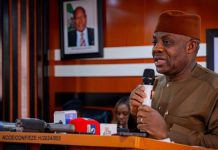Due to recent risk-off attitude, Nigerian US dollar bonds are subject to sporadic sell pressure on the global securities market, which has raised the average yield beyond 10% and reached a four-month high in 2024.
holders of investors Nigeria’s sovereign Eurobond sold off a few properties. The US Federal Reserve expects to maintain high interest rates for longer than expected. This coincides with the most recent sales of US Treasury bonds.
According to market statistics, the US Treasury’s seven-year auction on Thursday saw a high yield of 4.716%, higher than the previous auction’s high of 4.185%.
Though the bid to cover ratio for the auction was 2.48—below the 2.61 ratio from the previous auction—investor sentiment was nevertheless weaker. Foreign investors reduce their interest in Nigeria’s US dollar bonds at the Eurobond market to unhook or free some funds tie to the assets.
The sell pressures caused yield to rise while Nigeria’s sovereign Eurobond market price declined. The negative trading activity contributed to a rise in the average yield by 0.13% to 10.03%, Cowry Asset Management Limited said in a note to investors.
The uncertainties in the macroeconomic environment has raised borrowing risks and foreign investors have been demanding for higher returns on their investment. Nigeria’s inflation rate climbing to 33.20% while benchmark rate was adjusted to 24.75% to anchor unstable price level.
According to market data, US Treasury yields rose as data show little room for interest rate cuts. The Q1 GDP headline figure was a mild 1.6% expansion. The yield on 10-year US Treasury rises 0.054 percentage point to 4.706%, the highest in more than five months. The yield on the 2-year US Treasury jumped 6.5 basis points to 4.998%, from 4.933% on Wednesday, after piercing the 5% level.
The yield on the 10-year UK government gilt touched 4.4% on Thursday, the highest since early November, following a rise in US yields after strong PCE inflation data pushed back expectations for interest rate cuts in the US.
The core PCE price index, surged by 3.7% in Q1, accelerating from the 2% increase in the previous quarter and above the estimate of 3.4%. In the secondary market for FGN Bonds, trading activity was on a cautious thread, as a result, the average yield declined marginally by 0.01% to close at 18.96%.














